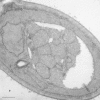The vacuole versus the lysosome: when size matters
- PMID: 24343261
- PMCID: PMC5396098
- DOI: 10.4161/auto.27367
The vacuole versus the lysosome: when size matters
Abstract
The morphometric examination of autophagic bodies provides useful information about the mechanism and magnitude of macroautophagy, and yeast researchers frequently utilize various measurements of these structures as part of their quantification of the process. The utility of this approach, however, has led to the common misconception that autophagic bodies can be found in the mammalian lysosome, which is generally not correct.
Keywords: autophagic body; autophagy; lysosome; stress; vacuole.
Figures




References
-
- Indge KJ. . The isolation and properties of the yeast cell vacuole. J Gen Microbiol 1968; 51:441 - 6; http://dx.doi.org/10.1099/00221287-51-3-441; PMID: 4968622 - DOI - PubMed
-
- Matile P, Wiemken A. . The vacuole as the lysosome of the yeast cell. Arch Mikrobiol 1967; 56:148 - 55; http://dx.doi.org/10.1007/BF00408765; PMID: 4873367 - DOI - PubMed
-
- Pratt P, Bryce J, Stewart G. . The yeast vacuole—a scanning electron microscopy study during high gravity wort fermentations. J Inst Brew 2007; 113:55 - 60; http://dx.doi.org/10.1002/j.2050-0416.2007.tb00256.x - DOI
-
- Eskelinen E-L, Reggiori F, Baba M, Kovács AL, Seglen PO. . Seeing is believing: the impact of electron microscopy on autophagy research. Autophagy 2011; 7:935 - 56; http://dx.doi.org/10.4161/auto.7.9.15760; PMID: 21566462 - DOI - PubMed
-
- Dice JF, Klionsky DJ. . Artophagy: the art of autophagy--macroautophagy. Autophagy 2010; 6:320 - 1; http://dx.doi.org/10.4161/auto.6.3.11263; PMID: 20118653 - DOI - PubMed
Publication types
MeSH terms
Substances
Grants and funding
LinkOut - more resources
Full Text Sources
Other Literature Sources
